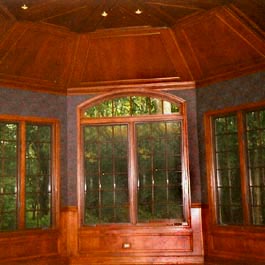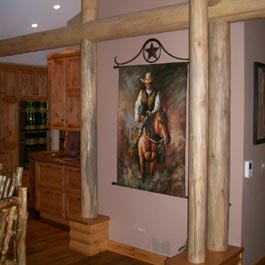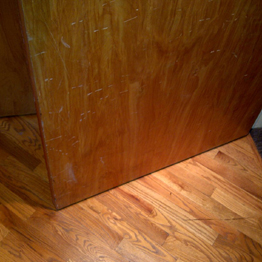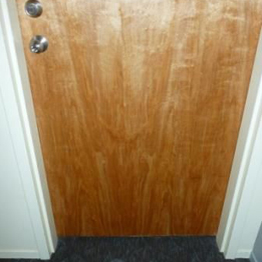Wood Staining, Stain Matching and Wood Toning
What You Can Expect
- The new windows or doors match the color of your old stained casings
- Stain colors that blend well with your decor
- Durable finish coats
- Will make new wood appear as if it has always been there
- Your old stained/varnished wood gets to look like new again, without stripping your woodwork.

Blending Four Different Woods
What We Do

Creating Harmony Between Woods
- Use wood conditioners on softer woods to ensure uniform color
- Field blend stains to achieve color match
- Produce stain samples on similar wood, for approval, prior to staining
- Custom mix clear coats to ensure good sheen match
- Add stain toner coat to hide nicks, scuffs and worn-out areas to make your woodwork to have a fresh look again.
Staining soft woods requires the use of wood conditioners
Pine is a wood commonly used for baseboards, casings, window sashes and doors. Because of its soft nature, pine absorbs stain in an uneven way, when applied directly over the wood, thereby making the stained wood look blotchy. To deal with this problem, our painters use a wood conditioner prior to staining, which evens out the absorption of the stain into the wood and enhances the aesthetics of the end result.
Stain samples on similar woods work
When you add new trim, replace a window or a door that had previously been stained, an important step in ensuring a good color match between the new work and the old staining is to do a sample using the same kind of wood as what is being used on the project. Because different woods all take stain differently, our painters use similar woods to produce stain samples.
Field blending stains ensures good color matching
When staining new wood that will be surrounded by other existing stained wood, it is important to match the stain colors as closely as possible. To produce the best result possible, our painters often blend different color stains to arrive at just the right color. Proceeding in this way ensures that all the stained wood, new and old, looks the same when we are done.
Matching the sheen of clear coats is important
Varnishes have a tendency to become dull over time as they age due to the oxidation process. When adding new work or touching up old stained wood, we test the sheen levels of the varnish we will use, versus the sheen of the old varnish. If necessary, our painters will blend varnishes with two different sheen levels in order to produce the best match possible.
Making old stained wood look like new
After living in a house for twenty years and having raised a family, the stained woodwork can get to look a little “beat up”. We can help you restore a fresh look to your doors, windows, baseboards and casings by applying a coat of toner to your woodwork and re-varnishing the surfaces. As shown in this picture, ninety-year old Craftsman-style woodwork can be made to look like new again.

90-year Old Door, Looking Beat-up and Tired

Looking New, After Toning and Revarnishing






